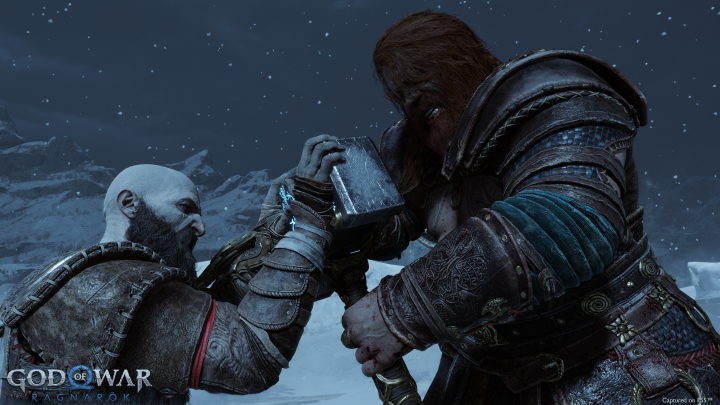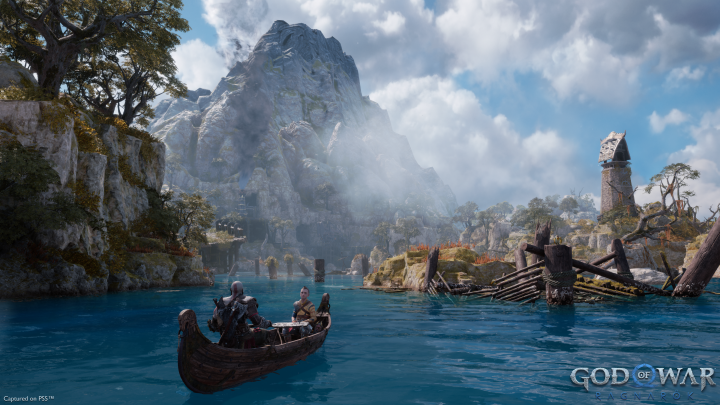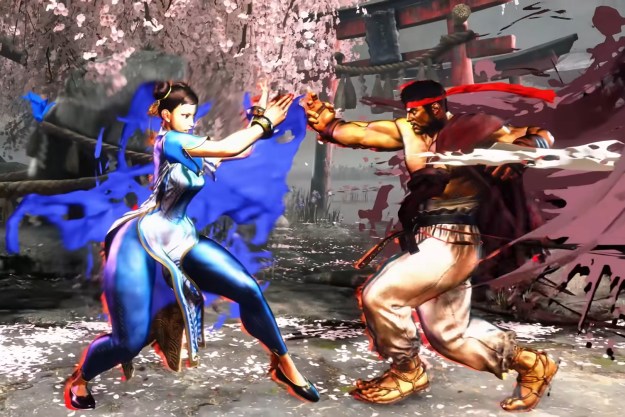
“God of War Ragnarok delivers more thrilling action in in a bigger, though not necessarily better, sequel.”
- Kratos' best characterization yet
- Fantastic combat
- More customization options
- Rewarding exploration
- Uneven story
- RPG systems still don't click
- Technically stagnant
About 25 hours into God of War Ragnarok, I experienced the thunderous action game’s first real moment of quiet. Returning from a long excursion to Svartalfheim with his way-too-chatty companions, Kratos walks into his bedroom and sits in silence as he reflects on his increasingly strained relationship with his son, Atreus. His normally unshakable stoicism cracks just enough to let a rare moment of vulnerability shine through, as you can almost catch a tear about to roll down his cracked face before he retreats to sleep – the one place where he can heal.
It’s both the best and most understated moment in a game that loves to lay it on thick.
The PlayStation exclusive action adventure is an undoubtedly impressive work, but Kratos does battle with a familiar foe here: sequel syndrome. In trying to one-up 2018’s phenomenal and self-reflexive God of War reboot, developer Santa Monica Studio took a “more is more” approach to development. There are more characters, more exploration, more puzzles, more quips — you name it. If there’s something you loved (or didn’t) about Kratos’ last outing, you can bet you’ll see twice as much of it here.
God of War Ragnarok is much bigger than its predecessor, though not inherently better. It’s more reminiscent of the jump between the original God of War in 2005 and God of War 2, offering a largely similar experience down to its plot beats. That larger scope makes for a messier story that loses some of the previous game’s intimacy, but the trade-off is even sharper combat that further establishes the franchise as the God of action games.
Video review
Ragnarok is coming
God of War Ragnarok is more of a “part two” than a sequel. It continues the story of reformed God-killer Kratos and his son Atreus, which was left feeling a little unfinished in 2018 after the duo inadvertently ushered in an early Fimbulwinter. The tale picks up three years later here, with the long winter finally coming to an end … which means that the cataclysmic Ragnarok isn’t far behind according to prophecy.
The story is at its best when it quiets down to focus on Kratos and Atreus’ relationship.
As you can probably imagine from that description, the sequel takes some much grander narrative swings than its predecessor. While the last installment was a refreshingly contained drama about Kratos’ strained relationship with his son, Ragnarok is more of a sprawling epic that’s more broadly focused on its retelling of Norse mythology. For instance, its cast of characters significantly expands with more imposing Gods, like Thor and Odin, and wise-talking sidekicks that quip like they’re auditioning for a superhero movie (the returning Mimir goes from funny to grating in no time flat here).
While the story is entertaining enough as a mythological romp, it’s a bit of a step down both in the context of Kratos’ previous adventure and on its own merits. 2018’s God of War was a groundbreaking moment for video game narratives when it launched largely because it was a game in conversation with its own past. It reexamined the hyper-violent series and deftly spun them into a moving story about a grieving father who’s desperate to make sure his child doesn’t inherit his mistakes. It’s an intimate game that keeps the focus (literally, thanks to its one-shot camera trick) on a handful of well-developed characters.

Ragnarok follows up on those ideas, albeit in a much less focused or introspective manner. Potentially thoughtful takeaways about parenting compete for time with vague musings about the nature of war and teenage tropes. There’s little room for subtlety as chatty characters tend to brain-dump their entire emotional state on one another to fill every moment of silence during exploration. The general pacing suffers from the scope increase, too, with the expanded cast creating more narrative side-diversions that can interrupt the core story for hours at a time. It feels like less of a game and more of a TV show blueprint, as if Sony anticipated that the property would need more characters if it wanted to turn it into a multimedia juggernaut like The Last of Us.
Unsurprisingly, the story is at its best when it quiets down to focus on Kratos and Atreus’ relationship. Amid all the apocalyptic noise, there’s a beautiful story here about a father learning to trust his son and cherish the time he has left with him before he’s whisked away by adulthood. Series veteran Christopher Judge sells those tender moments with a tremendous performance as Kratos, playing the most vulnerable (and most deadpan hilarious) version of the character we’ve seen to date.

There’s a touching moment that sticks with me as I reflect on the messy adventure. During a trip to Valheim, the animal-loving Atreus insists that Kratos stop to free a jellyfish imprisoned in the sand. The two traverse through a long dungeon, working together to get the creature out. At the end, Atreus wonders why Kratos would halt his world-saving quest for an unnecessary rescue mission. The answer is simpler than Atreus thinks: Kratos just wants to spend as much time as he can with his son with the time they have left together, come death or cataclysm. By the end of my journey, I wished I could have had more of those moments with them, too.
The ultimate action game
Though its approach to narrative may split fans, Ragnarok’s combat is undeniably spectacular. Building off the foundation of the previous game, the sequel keeps everything that worked intact but turns the dials just enough to make battles feel new. For one, Kratos can use both his satisfyingly heavy Leviathan Axe and his speedy Blades of Chaos (which were a late-game addition in 2018) right from the jump this time. That makes combat more varied upfront, as I could seamlessly switch between tools depending on whether I needed to take out a bunch of foes quickly or focus my strength on one.
With enough tinkering, I was able to create my ideal action game out of my favorite bits and pieces of the genre.
The big change here is an increased emphasis on elemental attacks. Holding the triangle button freezes Kratos’ axe, while rapidly pressing it sets his blades on fire. Both give Kratos access to even more attacks, widening out his already impressive move set via skill trees. There’s a much better incentive to actually use those attacks, too. Perform them enough times and players can add a modifier to an individual move, boosting its damage, stun, and more. That adds a new layer of customization to the mix that lets players personalize an otherwise straightforward set of moves.
That system goes hand in hand with the RPG framework introduced in 2018, which remains a little hit-and-miss here. Stat increases still feel negligible, making the “numbers go up” equipment chase feel more tiring than satisfying. However, gear perks shine more this time. By the end of the game, I was wearing clothing that would allow me to heal by finishing enemies like Doom and freeze time on successful dodge rolls like Bayonetta. With enough tinkering, I was able to create my ideal action game out of my favorite bits and pieces of the genre.
I especially appreciate that Ragnarok gives me more opportunities to put my build to the test. In the previous game, the only true skill check came from blisteringly tough Valkyrie fights that drew Dark Souls comparisons. A variation of those returns here, but there are more memorable monsters beyond that, which pushed me to utilize every tool in my arsenal. One fight against a massive beast locked in a treasure vault pushed me to master my otherwise ignored parrying skills, which deepened my approach to battle for the rest of my journey.

Companions play a much bigger role in this game, too. Atreus is particularly more instrumental in battle, which adds some welcome variety to the mix. And while I won’t go into specifics on what role he plays, there’s a reason we spend so much time with Atreus in the sequel: Ragnarok’s story is ultimately about him more than Kratos. Even though we spend significantly more time with his dad, this is a coming-of-age story about a teenager searching for his own identity – something that was teased by the previous game’s surprising final twist. I suspect that decision might be polarizing for some fans, especially since actor Sunny Suljic can’t match up to Judge’s tour-de-force Kratos (the young Suljic’s real voice was maturing through production). However, it’s the one area where Santa Monica Studio really feels like it’s confident enough to break out of its comfort zone and add something new to a sequel that otherwise plays it safe.
Bigger, not better
Right from one of the game’s opening sequences, it’s clear that Santa Monica Studio is sticking closer to a formula this time around. The 2018 game’s most memorable narrative beats are echoed here in a manner that feels a little calculated, as if working from a slide deck of what fans responded well to and trying to double down. In fairness, this is a critique you could raise against just about any game sequel (see the excellent Horizon Forbidden West) and it’s not something that negatively impacts the game; it just isn’t exactly addictive either.
It’s not better. It’s not worse. It’s just more.
Take exploration, for instance. God of War (2018) was praised for its smaller open-world area, the Lake of the Nines, which allowed Kratos and Atreus to sail around in search of substantial side-quests. That idea is repeated here in multiple open spaces across the nine realms that follow the same general format. What worked in 2018 still very much works here. Exploration is extremely rewarding thanks to massive spaces that are filled with valuable treasure and clever environmental puzzles (though companions do not trust that you know how to solve them, judging by their constant hints). Side-quests are still a highlight, too, as some of the best narrative moments come from entirely optional content. One of the earliest side-missions has Kratos freeing a trapped whale whose body turns into its own puzzle island, a standout quest that cleverly reflects Kratos’ own insecurities.
I couldn’t help but feel like moments tended to blur together this time, though. The glut of puzzles, the increase in collectibles, the excess of small talk while riding around between locations — little of it sticks with me in the same way that my comparatively compact trip around the Lake of the Nines still does to this day. Sure, it’s all fun, but overexposure makes individual moments stand out less in the grander realm-jumping adventure. It’s not better. It’s not worse. It’s just more.

It doesn’t help that Ragnarok doesn’t feel like as much of an improvement on the technical side either. Despite running on PS5, this very much feels like a PS4 game down to the way it hides loading with a clever realm travel trick. Ultimately, it’s not something that bothers me. Ragnarok is inseparable from its predecessor and it’s only fair that fans who haven’t upgraded yet get to actually see an incomplete story through to its end. But it does add to the feeling of stagnation, further binding it to the great, but safe God of War 2.
If I sound like Kratos being too hard on his son here, it’s because I can see what this series is capable of. Santa Monica Studio beautifully reinvented the franchise in 2018 with a bold game that stands among the best of its generation. For all my critiques, God of War Ragnarok is still miles ahead of its peers thanks to its unmatched action, awe-inspiring landscapes, and emotional storytelling. I wanted more from the sequel, as I expect many fans will, but I still have a lot to learn from Kratos in that regard. Perhaps I need to stop being so anxious for it to mature and instead appreciate it for what it is, growing pains and all.
God of War Ragnarok was reviewed on PS5.
Editors' Recommendations
- PS5 Pro: news, rumored release date, price, and specs
- Best PS5 game deals: discounts on the best games of 2023
- The 5 best HDMI cables for PS5 in 2024
- How to connect Bluetooth headphones to a PS5
- The best PS5 games for 2024





